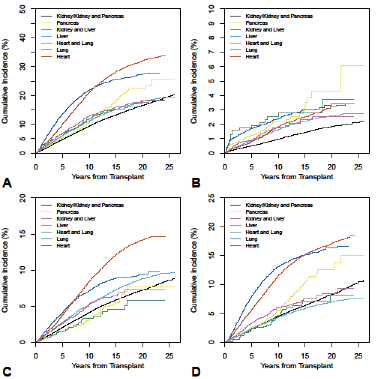Predictors of Malignancies Across Solid Organ Transplantation.
1Multi Organ Transplant Program, University Health Network, Toronto, ON, Canada
2Division of Biomedical Statistics and Informatics, Mayo Clinic, Rochester, MN
3Division of Gastroenterology and Hepatology, Mayo Clinic, Rochester, MN
Meeting: 2017 American Transplant Congress
Abstract number: C259
Keywords: Immunosuppression, Malignancy
Session Information
Session Name: Poster Session C: PTLD/Malignancies
Session Type: Poster Session
Date: Monday, May 1, 2017
Session Time: 6:00pm-7:00pm
 Presentation Time: 6:00pm-7:00pm
Presentation Time: 6:00pm-7:00pm
Location: Hall D1
Background & Aims:
Solid organ transplant recipients are at much higher risk of cancer as compared to the general population. The aim of this study was to compare prevalence and risk of malignancy in all solid organ transplant (SOT) recipients.
Methods: The Scientific Registry of Transplant Recipients (SRTR) database comprising all adult solid organ transplant (SOT) recipients across the U.S. between 2000 and 2011 was analyzed.
Results: There were 534,472 solid organ transplants over this time period, with 53,783 total de novo malignancies diagnosed (15.8% by 15 years post-transplant). The overall 15-year incidence of malignancies (including skin, hematologic/PTLD and solid organ malignancies) was 13.2% for kidney±pancreas, 17.9% for pancreas alone, 15.2% for liver, 28.1% for heart, and 25.6% for lung transplant.  Relative to kidney±pancreas transplant, all other SOT except liver experienced higher risk of de novo malignancy after adjusting for other risk factors. Pancreas and lung transplant recipients had highest risk of hematologic, whereas heart and lung had highest risk of solid organ and skin cancers. On multivariable analysis, age (p<0.001), gender (p<0.001), Caucasian race (compared to African American, Hispanic and Asian, p<0.001), previous malignancy (p<0.001), and donor characteristics (age p=0.003 and Caucasian race compared to other races, p=0.025) were associated with increased de novo malignancy risk, whereas mTOR inhibitor use was associated with slightly decreased risk (p=0.013).
Relative to kidney±pancreas transplant, all other SOT except liver experienced higher risk of de novo malignancy after adjusting for other risk factors. Pancreas and lung transplant recipients had highest risk of hematologic, whereas heart and lung had highest risk of solid organ and skin cancers. On multivariable analysis, age (p<0.001), gender (p<0.001), Caucasian race (compared to African American, Hispanic and Asian, p<0.001), previous malignancy (p<0.001), and donor characteristics (age p=0.003 and Caucasian race compared to other races, p=0.025) were associated with increased de novo malignancy risk, whereas mTOR inhibitor use was associated with slightly decreased risk (p=0.013).
Discussion: Malignancy risk varies across solid organ transplant groups, with liver transplant at lowest, and lung transplant at highest risk. This is suggestive of risk correlating with degree of immunosuppression, and a slightly protective effect from mTOR inhibitor-based immunosuppression. Increased age, male gender, previous malignancy and Caucasian race are particularly important recipient characteristics that should prompt heightened vigilance in cancer screening protocols.
CITATION INFORMATION: Bhat M, Mara K, Dierkhising R, Watt K. Predictors of Malignancies Across Solid Organ Transplantation. Am J Transplant. 2017;17 (suppl 3).
To cite this abstract in AMA style:
Bhat M, Mara K, Dierkhising R, Watt K. Predictors of Malignancies Across Solid Organ Transplantation. [abstract]. Am J Transplant. 2017; 17 (suppl 3). https://atcmeetingabstracts.com/abstract/predictors-of-malignancies-across-solid-organ-transplantation/. Accessed December 23, 2025.« Back to 2017 American Transplant Congress
